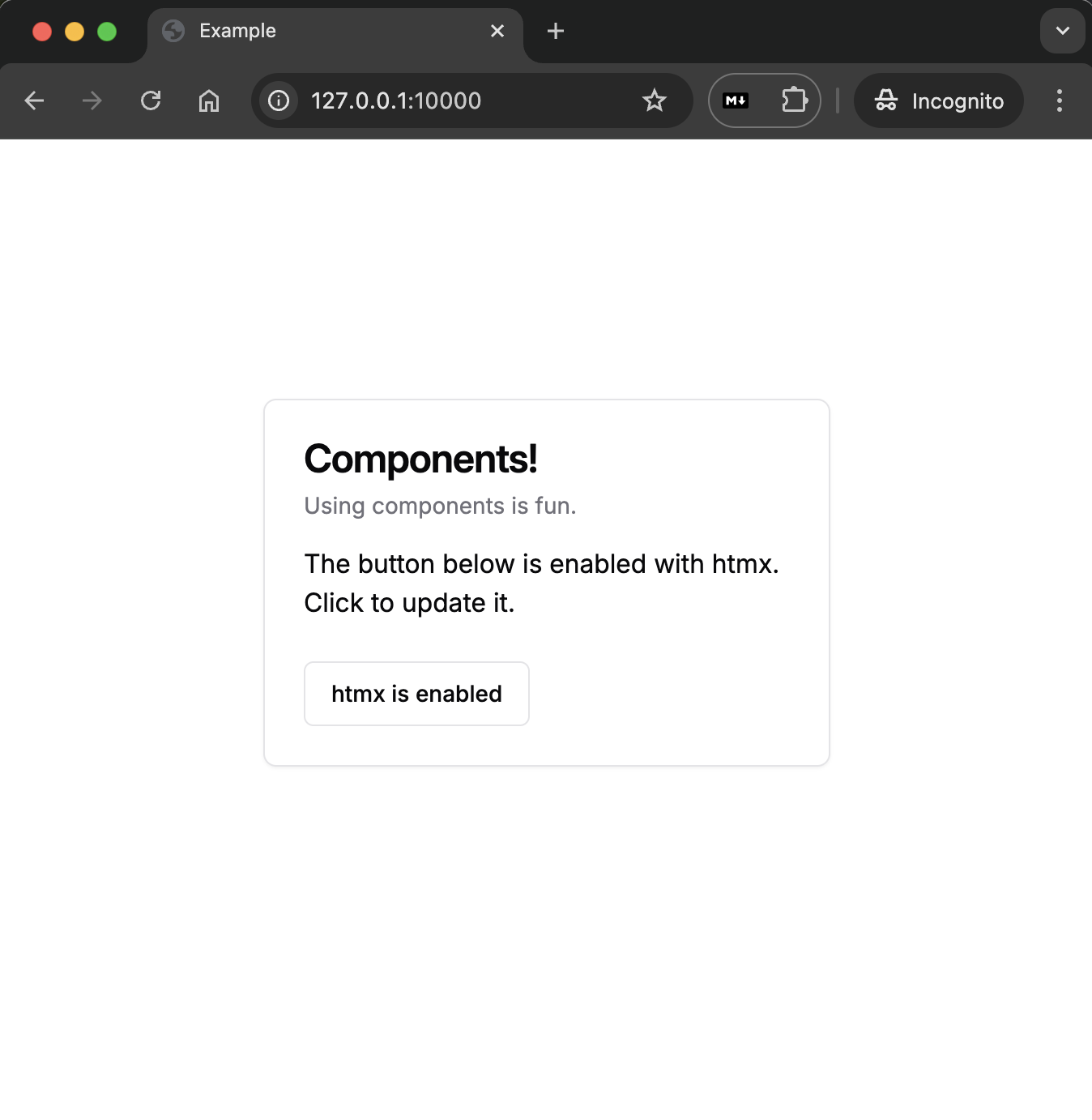Django
Setting up Django to serve components.
This guide demonstrates how to set up a minimal Django application with Basic Components, showcasing:
- JinjaX component integration
- Tailwind CSS styling
- Alpine.js interactivity
- HTMX dynamic updates
Prerequisites
Before starting, ensure you have:
- Python 3.8 or higher
- UV
- Node.js 16+ and npm 8+
- A text editor or IDE
Project Structure
The source is in examples/django:
examples/django/
├── app.py # Single-file Django application
├── components # JinjaX components
│ └── ui
│ ├── button
│ │ └── Button.jinja
│ └── card
│ ├── Card.jinja
│ ├── CardContent.jinja
│ ├── CardDescription.jinja
│ ├── CardFooter.jinja
│ ├── CardHeader.jinja
│ └── CardTitle.jinja
├── package-lock.json
├── package.json # npm config (Tailwind)
├── pyproject.toml # python project config
├── static # Static assets
│ ├── dist
│ │ └── output.css # Compiled Tailwind CSS
│ └── src
│ └── input.css # Source Tailwind CSS
├── tailwind.config.js # Tailwind config
├── templates # Jinja template dir
│ └── index.html
└── uv.lock
<!doctype html>
<html>
<head>
<title>Example</title>
<!-- Include the Alpine.js library -->
<script defer src="https://cdn.jsdelivr.net/npm/alpinejs@3.14.1/dist/cdn.min.js"></script>
<!-- Include the TailwindCSS library -->
<link href="/static/dist/output.css" rel="stylesheet"/>
<!-- tailwind inter font -->
<link rel="stylesheet" href="https://rsms.me/inter/inter.css"/>
<!-- htmx -->
<script src="https://unpkg.com/htmx.org@1.9.12"></script>
</head>
<body class="min-h-screen bg-white dark:bg-black text-black dark:text-white">
<div class="mt-40 flex justify-center justify-center w-full">
<!-- Card component example -->
<Card className="w-[350px] mb-4">
<CardHeader className="pb-3">
<CardTitle>Components!</CardTitle>
<CardDescription className="max-w-lg text-balance leading-relaxed">
Using components is fun.
</CardDescription>
</CardHeader>
<CardContent>
The button below is enabled with htmx. Click to update it.
</CardContent>
<CardFooter>
<!-- use htmx -->
<Button
variant="outline"
hx-get="/button"
hx-trigger="click"
hx-target="this"
hx-swap="outerHTML">htmx is enabled</Button>
</CardFooter>
</Card>
</div>
</body>
</html>"""
Django example application demonstrating:
- JinjaX component integration
- Static file serving for Tailwind CSS
- HTMX dynamic updates
- Component rendering
"""
from pathlib import Path
import django
from django.core.management import execute_from_command_line
from django.urls import path
from django.shortcuts import render
from django.conf import settings
from django.conf.urls.static import static
from django.core.wsgi import get_wsgi_application
from django.http import HttpResponse
from basic_components.utils.tailwind import tw
from basic_components.utils.jinjax import setup_component_catalog
import jinja2
import jinjax
# Only configure settings if they haven't been configured yet
if not settings.configured:
# Configure Django settings
BASE_DIR = Path(__file__).resolve().parent
settings.configure(
DEBUG=True,
SECRET_KEY="insecure-key-for-demo",
ROOT_URLCONF=__name__,
MIDDLEWARE=[
"django.middleware.security.SecurityMiddleware",
"django.middleware.common.CommonMiddleware",
],
INSTALLED_APPS=[
"django.contrib.staticfiles",
],
TEMPLATES=[
{
"BACKEND": "django.template.backends.jinja2.Jinja2",
"DIRS": [BASE_DIR / "templates"],
"APP_DIRS": True,
"OPTIONS": {
"environment": f"{__name__}.environment",
},
}
],
DATABASES={
"default": {
"ENGINE": "django.db.backends.sqlite3",
"NAME": BASE_DIR / "db.sqlite3",
}
},
STATIC_URL="static/",
STATICFILES_DIRS=[
BASE_DIR / "static",
],
)
django.setup()
# Configure JinjaX environment
def environment(**options):
env = jinja2.Environment(**options)
env.add_extension(jinjax.JinjaX)
# Add cn to globals
env.globals["cn"] = tw
# Setup JinjaX catalog
catalog = jinjax.Catalog(jinja_env=env)
setup_component_catalog(catalog)
return env
def get_catalog():
return django.template.engines["jinja2"].env.globals["catalog"]
# Define views
def index(request):
return render(request, "index.html")
def button(request):
"""Example endpoint demonstrating direct component rendering.
Used by htmx for dynamic button updates.
"""
catalog = get_catalog()
return HttpResponse(
catalog.render("Button", variant="destructive", _content="HTMX IS ENABLED!")
)
# URL patterns
urlpatterns = [
path("", index),
path("button/", button, name="button"),
] + static(settings.STATIC_URL, document_root=settings.STATIC_ROOT)
# WSGI application
application = get_wsgi_application()
# Command line interface
if __name__ == "__main__":
execute_from_command_line(["manage.py", "runserver", "0.0.0.0:10000"])Setup Instructions
Install Dependencies
# Navigate to project directory
cd examples/django
# Install npm dependencies for Tailwind
npm install
# Build Tailwind CSS
npm run build
# Create and activate Python virtual environment
uv sync
source .venv/bin/activateRun the Application
# Start Django server
python app.pyYou should see:
Watching for file changes with StatReloader
Performing system checks...
System check identified no issues (0 silenced).
Django version 4.2.x, using settings None
Starting development server at http://0.0.0.0:10000/
Quit the server with CONTROL-C.Enable Tailwind Watch Mode In a separate terminal:
npm run watchVerify Installation
- Open your browser to http://localhost:10000
- You should see the example page with:
- Styled components using Tailwind CSS
- Working htmx button that updates on click
- Dark mode support

Common Issues and Solutions
-
Styles Not Updating
- Ensure Tailwind watch process is running
- Check that
static/dist/output.cssis being served - Verify static files configuration in
app.py - Clear browser cache
-
Components Not Found
- Check component directory structure
- Verify JinjaX catalog configuration
- Ensure component names match file names
- Check component file extensions (.jinja)
-
Static Files 404
- Verify STATICFILES_DIRS setting
- Check static URL configuration
- Ensure StaticMiddleware is enabled
-
htmx Not Working
- Check browser console for errors
- Verify htmx script is loaded
- Confirm URL patterns are correct
- Check htmx attributes on components
Next Steps
- Review the Components Guide to learn about available components
- Explore Modern Tools to understand the tech stack
- Check out the Examples for more usage patterns
- Consider expanding to a full Django project structure for larger applications